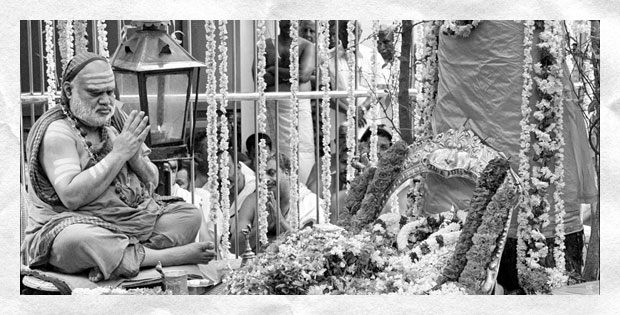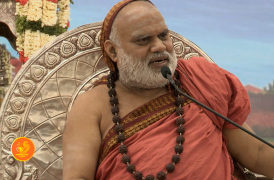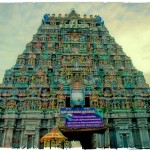
Karur: JUNE 6-8, 2012
The Power of the Mere Glance of Mahatmas
Jagadguru Shankaracharya Sri Sri Bharati Tirtha Mahaswamiji arrived in Karur on the evening of June 6, 2012 and was offered Poorna kumbha at the entrance of Pashupateeshwarar temple. A procession along one of the arterial streets of Karur was organized. Dhuli Pada Puja was then performed to the Jagadguru and the Swagata Patrikas read in Sanskrit and Tamil highlighted the association between the Sringeri Sharada Peetham and Karur. The Patrikas also remembered the visits of the prior Acharyas of Sringeri to Karur.
In His Anugraha Bhashanam, the Jagadguru said that His Guru, Parama Guru and Parameshti Guru had come to Karur, performed Chandramoulishwara Puja here and blessed the devotees. Close to Karur is Nerur, the Samadhi place of Sri Sadashiva Brahmendra. Our Parameshti Guru, Jagadguru Sri Sri Sacchidananda Shivabhinava Narasimha Bharati Mahaswamiji had come to Nerur, had Darshan of the Adhishtanam of Sri Sadashiva Brahmendra there, had composed hymns on Brahmendra and had given His Anugraha to the people here.
About 200 years ago, Sri Sadashiva Brahmendra lived in this region, attained mastery in the Shastras, embraced Sannyasa and shone as a great personage. A Sannyasi must live without any desires, away from the association of people and remain in contemplation of the Supreme Truth. When we say a Sannyasi must not have association of people, we mean that a Sannyasi should not yearn for disciples to come to him and pay homage to him. He should not desire to live in a place surrounded by disciples. He must remain focussed on divine contemplation. He need not see anyone nor need anyone see him. Such is the characteristic of a true Sannyasi. Sri Sadashiva Brahmendra was such a true Sannyasi. Not only did He have great scholarship in Yoga Shastra, He also adhered to all the Yogic practices. Not only was He adept in the Vedanta Shastra, He also was ever contemplating on the Supreme Tattva. He is such a perfect example of a Mahayogi and a Maha Vedantin and His life was led in such a way that it was amazing that such an ideal could be seen even in this Kali Yuga. That is why Jagadguru Sri Sri Sacchidananda Shivabhinava Narasimha Bharati Mahaswamiji worshipped Him.
It is in the tradition of the Acharyas of the Sringeri Sharada Peetham to offer prostrations only at the Adhishtanams (Samadhi Shrines) of their Gurus. They do not go and offer prostrations at the Adhishtanam of any other Adhishtanams. However, our Parameshti Guru, Jagadguru Sri Sri Sacchidananda Shivabhinava Narasimha Bharati Mahaswamiji created an exception to this rule at the Adhishtanam of Sri Sadashiva Brahmendra.
The Jagadguru said that the residents of Karur are blessed that the Adhishtanam of Sri Brahmendra at Nerur is so close to Karur. The residents of Karur have the opportunity of going to the Adhishtanam at any time. The Jagadguru pointed out that securing the blessings of Mahatmas brings about welfare in life. It is enough that Mahatmas get the thought “Let this man or family be well”. They need to do nothing else. Such a thought in the minds of Mahatmas brings great good. Even if their sight falls on you, it is a great blessing.
The Jagadguru then cited an instance from the life of His Paramaguru, Jagadguru Sri Chandrashekhara Bharati Mahaswamiji whose life paralleled that of Sri Sadashiva Brahmendra. The only difference between the two was that while Sri Brahmendra was a Sannyasi with no bonds, the Mahaswamiji was the Peethadhipati of Sharada Peetham. The Mahaswamiji had undertaken a Vijaya Yatra across South India in the 1920’s spanning four years. When the Mahaswamiji was in Madurai, a devotee desired to bring his friend for the Mahaswamiji’s Darshan. But the friend was an atheist to the core. He used to laugh at people offering prostrations to Sannyasis and scorned at Sannyasis that they had adorned the Kashaya Vastram (ochre robe) as a means of filling their stomachs. He had even taken a vow that he would never bow down before a Sannyasi. This friend of the devotee had first refused to come for having the Darshan of the Mahaswamiji but gave in to the devotee’s insistence under the condition that he would come for Darshan in his civilian dress and would not bow before the Mahaswamiji. As they arrived at the location, the Mahaswamiji had already begun giving Darshan. Everyone having Darshan was in the traditional attire and offering prostrations. This atheist could not control his laughter at this sight. All this while, the Mahaswamiji had not looked at this person. At the end of the Darshan, the Mahaswamiji arose and started walking back (to his chambers) and the atheist stood watching. Suddenly, the Mahaswamiji turned and looked straight at the atheist. Instantly, the atheist fell to his feet and prostrated before the Mahaswamiji. This true incident is an illustration to the power of the Drishti of a Mahatma. The mere glance of the Mahaswamiji had burnt all his atheistic tendencies to ashes in an instant, had made him humane and had made him fall at His Feet. Having prostrated, the man refused to get up. The Mahaswamiji asked him to get up but he replied, “If Your Holiness forgives this great sinner, I will get up”. The Mahaswamiji gave His word and the man got up and stood transformed from being such an atheist to being a Parama Astika. The Mahaswamiji asked him to come to the next camp the following day and said He will speak to him then. The following day, the man shed off his Western attire, had his sacred thread reinvested through a Purohit and came in traditional attire for the Mahaswamiji’s Darshan. He became an ardent devotee of the Mahaswamiji, learned Sanskrit and composed many Sanskrit hymns on the Mahaswamiji. He even wrote the Puja Vidhanam of the Mahaswamiji. Such was the power of the Mahaswamiji’s Drishti. One need not think that the Mahatma has not spoken a word. If the Mahatma’s Drishti falls upon you, that suffices.
The Jagadguru again reminded that Sri Sadashiva Brahmendra was such a Mahatma. That is why we worship at His Adhishtanam. Hence everyone must tke efforts to secure the blessings and grace of Mahatmas. It is not easy to say who is a Mahatma for a Mahatma does not proclaim himself to be a Mahatma. Today many roam around proclaiming themselves to be a Jagadguru or a Shankaracharya. However, none of these people have the necessary eligibility. Mahatmas prefer to remain away from the glare of the masses. However, everyone must strive to seek the blessings of such a Mahatma.
The Jagadguru mentioned that He had come to Karur so that He could go to Nerur and offer worship at the Adhishtanam of Sri Sadashiva Brahmendra. The Jagadguru remembered that His Guru, Jagadguru Sri Sri Abhinava Vidyatirtha Mahaswamiji had established the Shankara Math at Karur in 1959 and had then consecrated Goddess Raja Rajeshwari. After the Sharada Chandramoulishwara Puja, the Jagadguru had Darshan of Goddess Raja Rajeshwari and stayed in the Sringeri Shankara Math at Karur.
Photos
Puja at the Adhishtanam of Sri Sadashiva Brahmendra at Nerur
On 7th June morning, the Jagadguru started for Nerur at 8 AM and was reverentially received with Poornakumbha Swagata at the entrance of the Adhishtanam of Sri Sadashiva Brahmendra. The Jagadguru had Darshan of Kashi Vishwanathar and Vishalakshi and then went for His Snanam. Soon afterwards, the Jagadguru arrived at the Adhishtanam of Sri Sadashiva Brahmendra located at the base of a Bilva Tree. The Jagadguru offered an elaborate Puja at the Adhishtanam with Abhisheka to the chanting of sonorous Vedic hymns, followed by Alankara, Archana and Mahamangalarati. This was followed by the Jagadguru leading the chanting of Sri Sadashivendra Pancharatna Stotram and Sri Sadashivendra Stava (consisting of 45 verses).
It may be noted here that the first verse of Sri Sadashivendra Pancharatna Stotram talks of an incident in Sri Brahmendra’s life and the Jagadguru in His Anugraha Bhashanam rendered the previous day at Karur, had remembered a similar incident from His Paramaguru’s life by talking about the atheist who turned into an Astika. The said verse goes –
यत्सन्दर्शनमात्रा-
द्भक्तिर्जाताप्यविद्धकर्णस्य ।
तत्सन्दर्शनमधुना
कृत्वा नूनं कृतार्थोऽस्मि ॥
I am indeed blessed to have the Darshan of Sri Sadashiva Brahmendra by whose Darshan even a Muslim became transformed and was filled with devotion
The incident that had happened in Sri Brahmendra’s life refers to the one where a Muslim chieftain turned a new leaf under strange circumstances. Once Sri Brahmendra immersed in the blissful state of the Self and oblivious of the outside world walked into the harem of a Muslim chieftain. The chieftain angered by the sight of a naked sage walking into his private chambers drew a sword and cut off one of the saint’s hands.Though blood gushed out from the shoulder, Sri Brahmendra simply turned back as if nothing had happened and continued to walk. Intrigued by this reaction, the Muslim chieftain realized that he had harmed an extraordinary person, took up the severed hand, rushed towards the Saint and fell at His feet. Sri Brahmendra acknowledged the change of heart in the chieftain with a compassionate smile, took the severed hand, reinserted it into his shoulder and walked away as if nothing had happened!
Both the Sadashivendra Pancharatnam and the Sadashivendra Stava refer to a number of such incidents in Sri Brahmendra’s life and describe His state of Jivanmukti. These two hymns have been etched in stone slabs, both in the Sanskrit Devanagari script and in the Tamil script right behind the Adhishtanam.
The assembled devotees spiritually relished the sight of the Jagadguru offering Puja at Sri Brahmendra’s Adhishtanam.
Photos
Visits Around Karur
After performing Puja at the Samadhi of Sri Sadashiva Brahmendra, the Jagadguru visited the Agrahara in Nerur and graced the Ashram of the young Sri Vidyashankara Saraswati Swamigal. Later, the Jagadguru walked across to the other side of the Agrahara where a plot of land was reserved for constructing a Sringeri Shankara Math in Nerur and laid the foundation stone for the Math. The Jagadguru then returned to Karur where devotees performed Bhiksha Vandanam and offered Pada Puja.
At 5 PM in the evening, the Jagadguru graced the town of Vangal about 10 km from Karur and performed the foundation stone ceremony for a Shiva temple. The Jagadguru also offered Akshata to the Shivalinga that had been brought from Kashi for the Prathishta at the temple and remained in silent contemplation for a few moments touching the Shivalinga.
In His Anugraha Bhashanam, the Jagadguru talked about the importance of temples and the significance of praying at the sanctum of God inside a temple. The Jagadguru noted that a Perumal temple already existed in the area and the construction of the Shiva temple would connote the fact that Lord Shiva and Lord Vishnu are not different. The Jagadguru announced that the Lord whose Linga had been brought from Kashi be consecrated with the name “Vishweshwara” and blessed the devotees led by Sri Ramesh Vangal. The Jagadguru then returned to Karur and performed the Sharada Chandramoulishwara Puja.
On 8th June, the Jagadguru gave Darshan in the morning and devotees offered Bhiksha Vandanam and performed Pada Puja.
In the evening, the Jagadguru had Darshan at Raja Rajeshwari temple in the Shankara Math at Karur and started towards the place of the next camp, Krishnarayapuram. En route, the Jagadguru graced the headquarters of the Karur Vysya Bank where the officials and employees welcomed Him with respect and devotion. In His Anugraha Bhashanam to the employees, the Jagadguru quoted the following Shloka –
परोपकारः पुण्याय पापाय परपीडनम् ।
एतद्विद्यात्समासेन लक्षणं पुण्यपापयोः ॥
Explaining in simple terms, Punya constitutes helping others while hurting others in any way constitutes sin. Those who sin do so with joy but suffer the consequences with tears – हसता क्रियते कर्म रुदता परिभुज्यते. Hence whatever be one’s profession, one must help others – this leads to welfare of the nation, of the society, of everyone around and of your own self. The Jagadguru also graced the Lakshmi Vilas Bank headquarters in Karur and blessed the owners and employees.
The Jagadguru then visited Sanappiratti (Narasimha Samudram) and laid the foundation stone for a Satsangha Bhavanam named Narasimha Sadanam. In His Anugraha Bhashanam, the Jagadguru said it was a matter of joy to know that His Parameshti Guru, Jagadguru Sri Sri Sacchidananda Shivabhinava Narasimha Bharati Mahaswamiji had graced Sanappiratti. The Jagadguru said that Vedadhyayana and Anushtanam of Vedic Karmas were being performed with great faith since time immemorial in Agraharas. The Jagadguru expressed that it is a matter of great concern that both Vedic scholars and the performance of Karmas with faith are not to be found or observed today. However, our nation will benefit only if the Agraharas are filled once again with such people engaged in the performance of Vedic Karmas. The Jagadguru said that His prayer to the Lord constituted that Agraharas be revived and people residing in the Agraharas be blessed. The Jagadguru mentioned He was pleased that the residents of Sanappiratti were taking some effort by bringing up a Satsangha Bhavanam and blessed that the village be filled once again with the presence of Vaidikas.











































